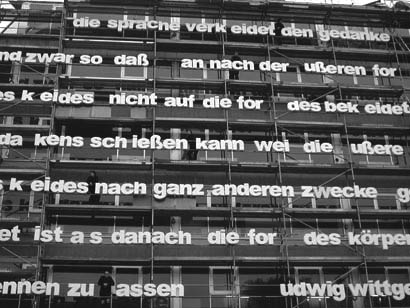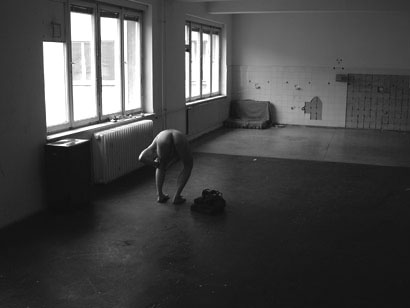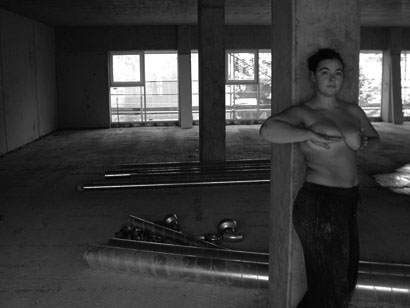märz 2001 – 07.02.03 anatomie sade/wittgenstein – a choreographic theatre work in 3 buildings: former leather factory, johannagasse 2, 1040 vienna | IP.TWO, lerchenfelder gürtel, 1160 vienna | halle g, museumsquartier, 1070 vienna (a)
|
press reviews german
publication
111 minuten skizzen (german)
body and building under construction (german)
body, building and theory under construction (german)
embody (german)
|
|
«anatomy sade/wittgenstein» is a choreographic theatre work, whose motives follow texts by marquis de sade and ludwig wittgenstein («la philosophie dans le boudoir» and «120 journées de sodom“ by marquis de sade, «über gewissheit» and «tractatus logico-philosophicus» by ludwig wittgenstein).
the project started in march 2001. the material of movements has been explored and developed in different places at vienna: (I) a former leather factory, (II) a building fabric and (III) the representative perfromance space of halle g in the museumsquartier.
the texts are not to be illustrated. they serve as methodical and associative backgrounds for our body-research. from the perspective of these two language-constructions, the choreographies are developed. in this work, we explore, how these texts leave marks on and/or disappear behind the muscles and the social engravings of each singular body.
the texts are to be understood as the methodical optic of the body-research.
the dancers/players have been working simultaneously but separately over a period of 8 months time on and with the different floors of a five-story building, each one working on his/her own individual material together with the director claudia bosse, without knowledge about the material of the colleagues and without communication. this was a specific experiment to generate a physical and artistic material succeeding a period of two years time which focused on chorus research. after this 8 months, the material has been combined.
|
 |
|
concept, choreography, space: claudia bosse, choreography, performing: markus keim, andreas pronegg, christine standfest, doris uhlich, guests since 08/02: maya bösch (choreographie, performing), martina luef (implemantation font), gini müller (context), anne schülke (context), readers: ingrid radauer, susanne peterka, uschi halmagyi, ilse urbanek, elfi sus u.a. trainings: milli bitterli, georg blaschke, christine kono, loulou omer, iwan wolfe.
partners: porr, BKK-3, brick-5, tanzquartier wien, prisma, eurofoam.
«anatomy sade/wittgenstein» was supportet by wien kultur.
|
|
|
I
in april/may 2002 «anatomy sade/wittgenstein» has been presented via 4 different «essays with spectators», the 111-minute-sketches. to each one of these sketches, one specific group of spectators has been exclusively invited into premises in the 5. viennese quarter, a former quite proletarian district: 1. artists and friends, 2. neighbours, 3. elderly ladies, 4. students of philosophy and formal logic. this was an exploration into and about the ways of representation and reception of different social groups of and within our work, also practically reflecting, how these ways modify our performance.
II
since august 2002 the theatercombinat co-operated with the architects of bkk 3 and worked within the construction of their new business premises: body and building under construction. the already existing material of movements was placed into this space, thus transformed and reshaped by this space. at the same time, further choreographic material was produced. this building with its architectural structure and aura participated in developing modes for spatial composition and combination of and for players and spectators. for example: concentration of all players in one room. distribution of the players in the entire building, i.e. one player on each floor. vertical and horizontal «rhythmisation» of the space. the spectators were invited to walk freely through the seven-store building and create their own perspectives. «to miss something» was part of the reception and thus of the experience.
the theory-performance-special body, building and theory under construction has been presented on the 6th of november 2002 from midnight till 7:00am in the morning, until the construction workers came to work. a 7 hour version of «anatomy sade/wittgenstein», with life-theory interventions during the performance. invited were: michael pfister and stefan zweifel (sade translator from zurich,/ «pornosophie and imachination»), birgit peter (institute of theatre vienna/ about nakedness), felicitas thun (academy vienna/ about body, authenticity etc.), gerald raunig (theorist/ about biopolitics and production), jonni winter (architect), gini müller (theatre and political activist) and others.
III
in february 2003, anatomy sade/wittgenstein has been presented in the tanzquartier vienna, as part of the project «embody», curated by mark tompkins. for this performance, the theatercombinat developed a specific version, a sort of sketch, as an essay to approach the representative space of halle g in the museumsquartier in vienna with its central perspective with our physical material. here, too, the spectators choose their own perspective, thus becoming part of the choreography. the spoken texts were the notes written by the performers during the two-years working process. the written texts (on the floor of the stage) were the parts of the body as appearing in de sade's «120 days of sodom» in chronological order. the duration was open. |
 |
|
 |
bodyinvestigation
claudia bosse
concept/room-constellations
|
|
bodywithouttext. the body is explored by exploring single parts of it. artificial movement versus socially generated patterns of movements. the body is re-constructed by re-working “segments”, thus explored as moveable and changeable material.
the actor proposes in exploring his/her body a certain rhythm, with or against he will work. i.e., the rhythm to be shaped is not an external one, but the own self-destined rhythm, becoming different, even strange, by permanent reproduction.
in this work, the body is understood as moveable individually shaped body-mass. the attempt is to comprehend its specific social-physical patterns in muscles and gestures. not the outer shape is the motor of the movement, but the exploration of muscles, movement of flesh-masses, transpiration of impulses. in each single movement, not the originality of an outer shape is interesting, but the attitude with the movement is done, the actual usage of a very clear and precise choreographic form in a specific and concrete constellation created by space and spectators.
1. spectator-communications
voyeurism
consciously showing/demonstrating intimate processes, including embarrassment and shame. operating with these feelings also of the spectators and their perspectives.(the player acts voluntarily and has to decide momentarily within certain rules of improvisation. intimacy is created within the simultaneousness of inventing and giving shape to this invention. the spectator, too, decides about the relation between closeness and distance.)
demonstrated interaction
in this mode of interaction with the spectator, interaction is shown as agreement. the interaction follows intelligible rules and opens up only certain possibilities of reaction, which are pre-structured by the mode of action. what is a situation, where the player creates a void which enables the spectator to interact in perceiving/using that void, not by forcing a certain reception? (the player becomes in this situation the spectator of the spectator and of the whole situation. simultaneity between player and spectator. the spectator is addressed as an acting person and not as an onlooker.
concealed interaction/ interaction masqué
the interaction is not the action’s crucial aim, but part of a situation created by the players. the interaction is a trick or luxury of the situation. there may be interactions identified as inter-acting by a third spectator but not necessarily by the interacting one. the interaction will not be visible by consent, it happens, but while happening it is not demonstrated or consciously shown.
2. body/images / languages / times
balance of forces between the bodies and the space.
the interdependencies between the construction of the space and the energy/tension invested by the bodies working in this space the bodies of the performers can use the spatial co-ordinates to realise/concentrate certain sequences of movement. other than the usual performance-spaces afford different energies and techniques to create physical presence. the expressive strategies of the bodies have to accept the specific structures and strategies of the concrete space. interest in different body-images, different sensitivities, different expressions of sex and gender – re-scribing theatre from the body.
shaped body
by trainings, the bodies are shaped, made conscious, re-worked in their social/biographical formations. this extends the possibilities of physical action, and it may open up new dimensions of physical fantasy. also, it may restrict physical fantasy by being reduced to certain skills.
exhausting/dissoluted body
body breaking out of form, removing itself from it’s form, unruledly expressing effects not known/calculated before. to try out something with the body, what you not already know you can do. unconscious action, ecstatic performance, identification with a movement, uncontrolled expression.
time-organising body
the relation of body and space creates a feeling of space-time within the spectator in this room. the rhythm of the artificially moving body of the performer in relation to the space and the common rhythm of the spectator creates a possibly conscious feeling for time within performer and spectator. the performer can manipulate this space-time by his/her time-organising movement (i.e. acceleration, slow down).
speaking body
rhythm and gesture (gestus) of the language organise rhythm and gesture of the body. breath and quality of the language shape breath and quality of the body. the dimension of the space and the distance to the addressee determine the economy of the speech and therefore the economy of the body. the body can be submitted to the laws of the speech, or you can oppose the body to the language and the organic speech. you can resist with(in) the body, use the energy of resistance, resulting of the tension between the act of the speech and the opposite physical act.
chorus-body
the chorus as body shapes itself and each single body of the chorus. the essay is an energetic exchange, a mutually shaping itself as a whole.
reacting body
reaction of the body to a specific situation, to another body, to a different organic. form and quality of the reaction (impulsively, retarded, discursive, physical) determine the transformation of the situation and it’s consequences for the whole situation.
3. physical space/spatial body
subsequent space
the clustered body/chorus. the distance of the bodies to each other is rather close. the cluster cuts through the room. the addition of movements builds a trace. the trace’s course describes the space, which constructs itself for the spectator subsequently.
stretched space
the space of action is related to the architecture of the place. the structure of the room is stretched by the “network” of the performers, set into the space as specific spatial structure. this room/structure can be permanently transformed by the courses/ actions/ changes of positions of the players (and spectators). each person within that space can change it’s structure. (room for interaction masqué).
simultaneous space
out of a concentrated sector of the space, the performer sets speech and movement, which can refer only to a small radius of action, but is related to the whole of the space in directing speech/movement, tension, energy, concentration to the whole space.
traces / scanned space
the spatial effect of the single body for the space emerges from a singular spot/position. by movements, traces of the single bodies, addition of their direction and their local changes the space will be de/inscribed.
the additive room
the stretched spatial body or the body leaving traces create a net between different sectors of the space, which opens up a specific relation to the whole of the space. the single sectors are not conceivable from one single point of view. as spectator, i am in rooms, leave them, enter another. for this perception, the movement of the spectator is necessary.
|
www.theatercombinat.com theatrale produktion und rezeption |